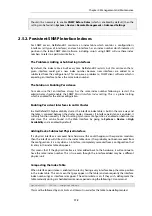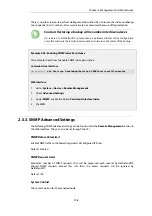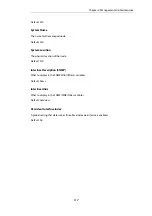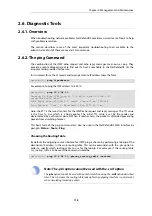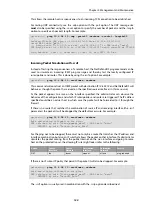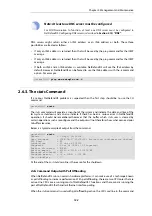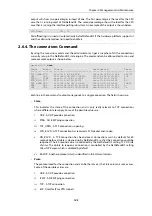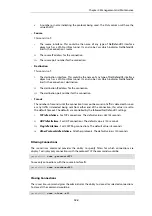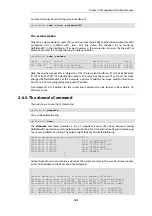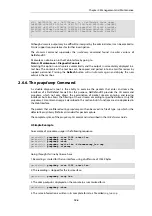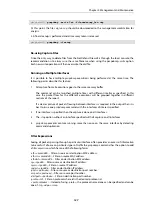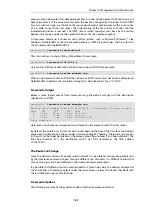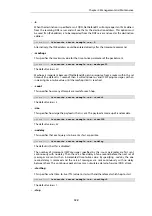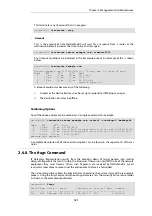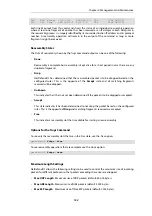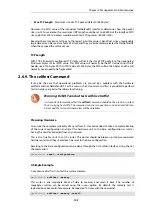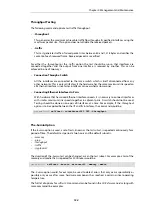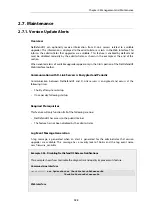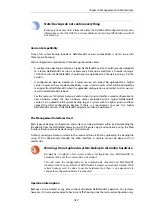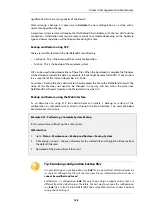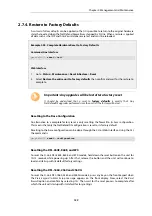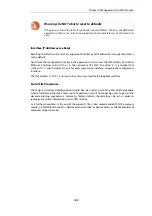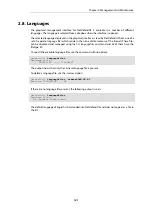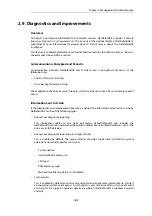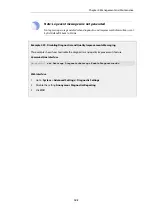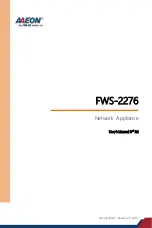
progressively incremented for subsequent packets. A router will decrement the time-to-live as a
packet traverses it. If the value becomes zero, the packet is dropped by the router and an ICMP
time-exceeded
message is sent back to the source which sends another packet with a time-to-live
of 2 in order to reach the next router. The incrementing of the time-to-live continues until the
intended destination is reached. The ICMP
time-exceeded
messages sent back by the routers
between the source and destination provide the basis for the traceroute output.
A traceroute command is found on many other systems such as Microsoft Windows™. Like
Windows, NetDefendOS sends its traceroute packets as ICMP ping messages. The basic form of
the CLI command in NetDefendOS is:
gw-world:/> traceroute <destination>
The
<destination>
can be an IPv4 or IPv6 address, for example:
gw-world:/> traceroute 192.168.4.1
Or it can be a DNS resolvable
Fully Qualified Domain Name
(FQDN), for example:
gw-world:/> traceroute server.example.com
When using traceroute with an FQDN then at least one DNS server must have been configured in
NetDefendOS to perform the resolution. Doing this is described in
.
Traceroute Output
Below is some typical output from traceroute using the default settings with the destination
specified as an FQDN:
gw-world:/> traceroute server.example.com
Tracing server.example.com [10.194.40.247], 30 hops max, 32 bytes of data
Hop#
RTT
RTT
RTT
Host
1
10 ms
10 ms
10 ms
10.4.16.1
2
10 ms
10 ms
10 ms
10.4.0.2
3
10 ms
0 ms
10 ms
10.194.40.247
Trace complete.
Here, each line of output corresponds to an attempt by traceroute to reach the next router.
By default, traceroute tries 3 times for each router hop and the
Round Trip Time
for each attempt
expressed in milliseconds is shown under a corresponding
RTT
heading. There were two routers
in the path to the target destination in the above output (hop number 1 and hop number 2). The
final hop (number 3) is the destination which was DNS resolved as the IPv4 address
10.194.40.247
.
The Route Can Change
Given the dynamic nature of a packet switch network, it is possible for consecutive packets sent
by the traceroute command to pass through different sets of routers. It is difficult to know that
this is occurring and it is not indicated in the traceroute command output.
It is possible that different routers could respond for a given hop value. The address displayed at
the end of lines of traceroute output under the
Host
column is always the router that dealt with
the last ICMP message sent for that hop.
Traceroute Options
The following are some of the important options for the traceroute command:
Chapter 2: Management and Maintenance
129
Summary of Contents for NetDefendOS
Page 30: ...Figure 1 3 Packet Flow Schematic Part III Chapter 1 NetDefendOS Overview 30 ...
Page 32: ...Chapter 1 NetDefendOS Overview 32 ...
Page 144: ...Chapter 2 Management and Maintenance 144 ...
Page 284: ...Chapter 3 Fundamentals 284 ...
Page 392: ...Chapter 4 Routing 392 ...
Page 419: ... Host 2001 DB8 1 MAC 00 90 12 13 14 15 5 Click OK Chapter 5 DHCP Services 419 ...
Page 420: ...Chapter 5 DHCP Services 420 ...
Page 573: ...Chapter 6 Security Mechanisms 573 ...
Page 607: ...Chapter 7 Address Translation 607 ...
Page 666: ...Chapter 8 User Authentication 666 ...
Page 775: ...Chapter 9 VPN 775 ...
Page 819: ...Chapter 10 Traffic Management 819 ...
Page 842: ...Chapter 11 High Availability 842 ...
Page 866: ...Default Enabled Chapter 13 Advanced Settings 866 ...
Page 879: ...Chapter 13 Advanced Settings 879 ...

